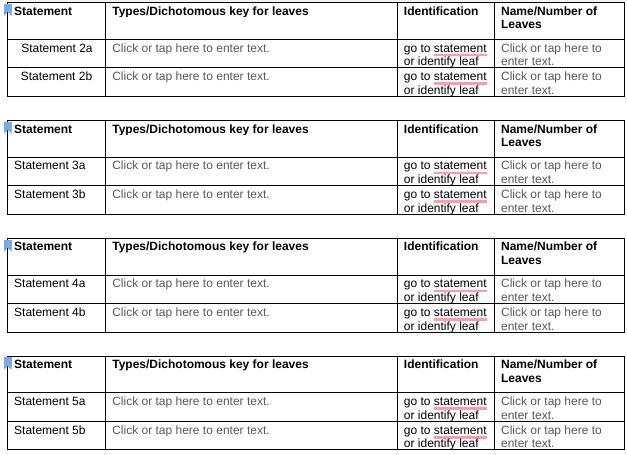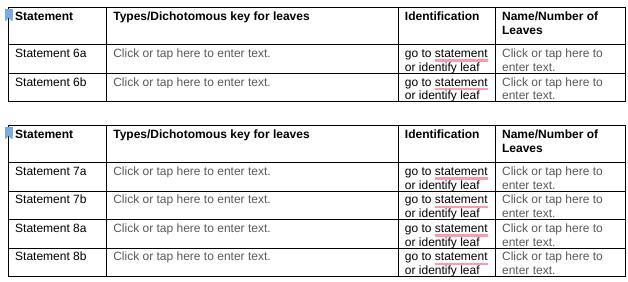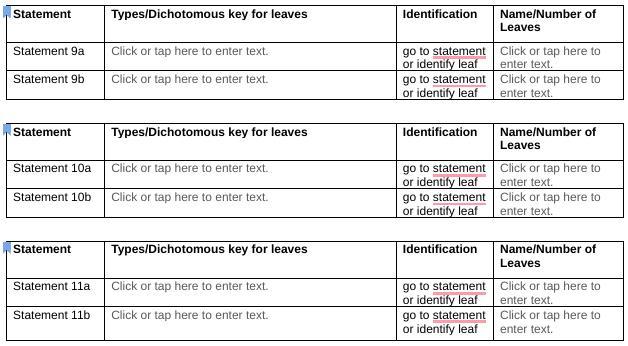Biology 3.03 Lab: Dichotomous Key 1. I desperately need help.
Create a dichotomous key that identifies the 10 leaves on the Common Leaves sheet. Look closely at those leaf samples and devise a dichotomous key that helps you identify them. Be sure that your dichotomous key contains only pairs of statements about a single characteristic. For example, a pair of statements might be:
A. leaf margin smooth
B. leaf margin toothed
However, you should avoid pairs of statements that do not address the same characteristic. The following pair, for example, would not be very informative in your key:
A. leaf margin smooth
B. leaf type needle-like
As you develop your key, test it out with the 10 leaves provided on the Common Leaves sheet. When you've developed a key that identifies all 10 leaves, type your statements, “go tos,” and identifications, following the format in the example below. The example is based on this lesson’s dichotomous key for birds.
Once you have completed your dichotomous key, answer the two remaining questions. When you are finished, submit this assignment to your teacher by the due date for full credit.
1. Complete a dichotomous key for the 10 leaves on the Common Leaves sheet. The chart provided here allows for 11 pairs of statements. Depending on how you build your dichotomous key, you may or may not need all of them, or you may need to add some.
2. Can more than one dichotomous key be developed to identify the same group of organisms? Explain. To answer this question, refer to this lesson’s dichotomous key for birds.
Answer:
Type your answer here.
3. If two different people use the same dichotomous key to identify the same organism, should they have different results? Explain.
Answer:
Type your answer here
I apologize if this makes no sense at all.





Answers
The following could serve as a dichotomous key to identifying the ten leaves: Oval or elliptic in shape. linear or lanceolate in form. cordate or triangular in form. Orbicular or reniform leaves. Oval or spatulate leaves. smooth leaf margin
What does a dichotomous leaf key entail?An instrument that assists in the identification of different leaf species is a dichotomous key for leaves. By offering two different explanations for each observation, it aids in the classification of species.
What kind of plant has a dichotomous key, specifically?For instance, a dichotomous key in tree identification would inquire as to whether the tree has leaves or needles. If the tree has leaves, the key then sends the user down one set of questions; if the tree has needles, an other list of questions is presented.
To know more about dichotomous key visit:-
https://brainly.com/question/2235448
#SPJ1
Related Questions
Quarter 1 Summative Assessment
Answers
Answer: ik this might not help but you have to put the specific question you want answered in or no one can help you
Explanation:
PLS HELP I GIVE BRAINLIEST
Fill a clear bin (shoe box size works best) about half way with dirt. The dirt can be from outside or a garden supply store.
Lightly moisten the dirt by sprinkling water over it.
Place about 5 worms in the bin. The worms can be dug up from outside or from a bait store.
Observe the worms, in a period of 2,5,10 minutes and 1 and 2 days
What do the worms do when first placed in the dirt.
After 2 minutes where are the worms?
After 5 minutes where are the worms?
After 10 minutes where are the worms?
When you return after one day what do you notice?
When you return after two days what do you notice?
Answers
When first placed in the dirt, the worms may burrow into the soil or crawl around on the surface.
Exploration.
Less crawling around.
Motionless on the soil.
Tunnel creation.
Visible casting.
What are the likelihoods of worm behavior?After 2 minutes, the worms may still be exploring their new environment or starting to burrow deeper into the soil. After 5 minutes, the worms may have burrowed deeper into the soil or be crawling around the surface less frequently. After 10 minutes, the worms are likely to have burrowed deeper into the soil or remain motionless on the surface.
When returning after one day, you may notice that the worms have created tunnels in the soil and have consumed some of the organic matter in the soil. They may also have deposited their castings, which are rich in nutrients. When returning after two days, you may notice that the worms have continued to create tunnels and consume organic matter, and their castings may be more visible.
Learn more on worm behavior here: https://brainly.com/question/15928167
#SPJ1
What are the effects of dam
removal on a river and its
watershed? of water does
Answers
Dam removal can affect water quality through the downstream transport of sediment-bound contaminants (e.g., organic substances and heavy metals) and the alteration of biogeochemical cycles.
Starting billions of years ago, algae lowered the. atmosphere. levels in the A. carbon dioxide D. oxygen C. ozone B. methane
Answers
Explanation:
ozone probably, I think
a cost benefit analysis balances the cost of an action against what
Answers
A cost-benefit analysis balances the cost of an action against its benefits.
It is a systematic process used to evaluate the pros and cons of a decision or project by comparing the expected costs with the expected benefits.
The costs can include financial expenses, time, resources, and any negative impacts incurred as a result of the action. On the other hand, the benefits encompass the positive outcomes, advantages, or gains derived from the action.
By assessing and quantifying both the costs and benefits, a cost-benefit analysis helps decision-makers determine whether the benefits of undertaking the action outweigh the costs and whether it is economically viable or beneficial to proceed with the proposed course of action.
Know more about cost-benefit:
https://brainly.com/question/27318112
#SPJ6
HELP WITH BIO HOMEWORK!!
Answer options:
a. Because foxes are smaller than jackals, gray wolves are less closely related to pampas foxes.
b. Given how little its DNA has changed, the golden jackal was the gray wolf's most recent ancestor.
c. Given that their DNA sequences are more similar, gray wolves and golden jackals are more closely related.
d. Because their DNA sequences differ greatly, scientists believe that the pampas fox was the gray wolves' earliest ancestor.
Answers
How are speciation and reproductive isolation similar and different?
Answers
Answer:
Look below
Explanation:
Reproductive isolation represents a breakdown in the ability to reproduce successfully with sexual partners of another type of organism, and speciation requires a build up of reproductive isolation between diverging types of organism until gene flow is sufficiently rare or ineffective that the entities are considered
give three functions of a fruit
Answers
Answer:
please make me brainalist and keep smiling dude I hope you will be satisfied with my answer
Explanation:
A fruit protects the immature seeds from animals and extreme climatic conditions. It stores food material. It attracts animals that help in dispersing or scattering the seeds to distant places.
Boost your digestion and heart health
Please guys tomorrow I have exams help me
Answers
The correct statement from the options about protons, electrons, and neutrons are:
TrueTrueFalseFalseFalseD. None (The idea that matter is 'continuous' was proposed by Aristotle)
D. Democritus
B. Neutron and proton
C. Mass number
What are protons, electrons, and neutrons?Protons, electrons, and neutrons are subatomic particles that make up atoms.
Protons are positively charged particles located in the nucleus (center) of an atom. The number of protons in the nucleus determines the element that the atom represents. For example, all carbon atoms have six protons in their nucleus, while all hydrogen atoms have one proton.
Electrons are negatively charged particles that orbit around the nucleus of an atom. Electrons are much smaller than protons and neutrons and are responsible for the chemical properties of an atom. The number of electrons in an atom is typically equal to the number of protons, ensuring that the atom has no overall electric charge.
Neutrons are neutral particles located in the nucleus of an atom, with a mass similar to that of protons. Neutrons do not carry a charge, but they do affect the stability and mass of an atom. The number of neutrons in an atom can vary, resulting in different isotopes of the same element with different masses.
Learn more about protons, electrons, and neutrons at: https://brainly.com/question/27548669
#SPJ1
Fermenter is the heart of fermentation process- explain
Answers
In the fermentation process, the fermenter is a container that offers a regulated environment for microorganisms to transform carbohydrates into desired products. It enables process monitoring and control, leading to high yields of high-quality goods.
What other names are given to fermenters?Fermentors, commonly referred to as bioreactors, are sterile, enclosed tanks used for the ideal development of microorganisms. Large-scale cultivation of the microorganisms is possible to develop metabolites with industrial applications.
What components of a fermenter are crucial?One of the fermentor's key components is the aeration system. To maintain optimum aeration and oxygen availability throughout the culture, a good aeration system must be chosen.
To know more about fermentation visit:-
https://brainly.com/question/31310689
#SPJ9
Which words from the article help the reader to understand the importance of a special habitat?
OPTIONS
Answers
Answer:
Since there is no specific article mentioned in the question, I will provide a general answer.
The importance of a special habitat can be conveyed through various words and phrases depending on the context. Some examples of words and phrases that may help the reader understand the importance of a special habitat are:
Unique
Endangered
Fragile
Ecosystem
Biodiversity
Rare
Sensitive
Threatened
Niche
Keystone species
Habitat loss
Conservation
Preservation
Sustainability
Irreplaceable
These words and phrases may be used to describe the ecological, scientific, or cultural value of a special habitat and emphasize the need to protect it from human activities and other threats that may cause harm or destruction.
I Hope This Helps!
I just want to know if i’m labeling this right.
Answers
The labelled diagram of structure of DNA and DNA replication has been attached below.
What happens in DNA replication?DNA replication is the process by which a cell copies its genetic material in preparation for cell division. It is a vital process that ensures that each new cell receives an exact copy of the genetic information carried by the parent cell.
The process of DNA replication occurs in the following steps:
Initiation: The DNA double helix is unwound by the enzyme helicase, creating a replication fork where the two strands separate.
Priming: Primase synthesizes short RNA primers along the DNA template strand to provide a starting point for DNA synthesis.
Elongation: DNA polymerase III binds to the RNA primers and begins adding nucleotides to the growing DNA strand in the 5' to 3' direction.
Termination: DNA polymerase I removes the RNA primers and replaces them with DNA nucleotides. DNA ligase then seals the gaps between the Okazaki fragments, joining the newly synthesized DNA strands together.
The process of DNA replication ensures that each new cell receives an exact copy of the genetic information carried by the parent cell. The accuracy of DNA replication is critical to the maintenance of genetic information and the prevention of mutations that can lead to genetic disorders or diseases.
To know more about DNA replication, visit:
https://brainly.com/question/16464230
#SPJ1
Which type of macromolecule contains phosphorus, and where in the molecule are phosphorus atoms located
Answers
Answer:
Nucleic acids, which include DNA (deoxyribonucleic acid) and RNA (ribonucleic acid), are the macromolecules that contain phosphorus. Phosphorus is an important component of the nucleotides that make up nucleic acids.
In DNA, the phosphate group is located on the 5' carbon of the sugar molecule, which is connected to the nucleotide base via a phosphodiester bond. The phosphate groups of adjacent nucleotides form the backbone of the DNA molecule.
In RNA, the phosphate group is similarly located on the 5' carbon of the sugar molecule, but RNA has a ribose sugar instead of a deoxyribose sugar. RNA also typically contains single-stranded nucleotides, rather than the double-stranded structure of DNA.
Overall, phosphorus plays a critical role in the structure and function of nucleic acids, which are responsible for storing and transmitting genetic information.
In fruit flies, brown bodies are dominant to black bodies. cross two heterozygous fruit flies. determine the phenotypic and genotypic ratios. then determine how many fruit flies, if 200 are born, will have black bodies
Answers
Answer:Cross a black fruit fly with a heterozygous fruit fly. Determine the phenotypic and genotypic rations of their potential offsping
Explanation: